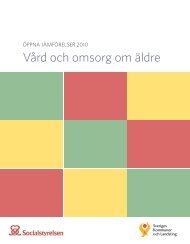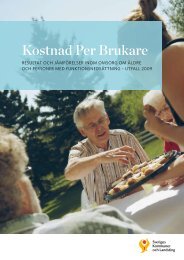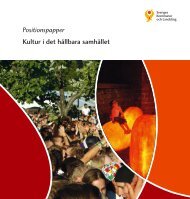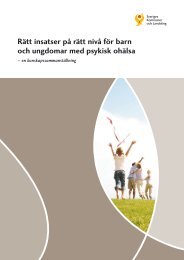Länk till produktdatablad - Webbutik - Sveriges Kommuner och ...
Länk till produktdatablad - Webbutik - Sveriges Kommuner och ...
Länk till produktdatablad - Webbutik - Sveriges Kommuner och ...
Create successful ePaper yourself
Turn your PDF publications into a flip-book with our unique Google optimized e-Paper software.
Results<br />
The aim of the teams was to reduce the number of healthcare-associated infections.<br />
For example, halving the incidence of urinary-tract infections by catheterising<br />
for the right indications, introducing closed urine collection systems for<br />
catheter treatment and giving the patient extra fluids to drink. Another goal was<br />
reducing both deep and superficial infections after primary hip and knee replacements:<br />
Skin bacteria were reduced by the patient’s taking double showers using<br />
Hibiscrub three times prior to the operation; airborne particles in the surgical<br />
theatre were minimised through the 20-second rule (that all staff stand s<strong>till</strong> for<br />
20 seconds so that particles can be carried away by the ventilation system); and<br />
the routines for sterile wound changes were improved. Hospitals have also seen a<br />
drop in ventilator-associated pneumonia in patients on respirators since implementing<br />
measures such as raising the head of the bed 30 degrees and improving<br />
the patients’ oral hygiene.<br />
The teams have achieved excellent results in both sessions of the project; 80<br />
percent reached their stated goals.<br />
Good hygiene is critical for good results. A particularly important procedural<br />
goal to avoid the spread of infection is that the staff follow basic hygiene routines.<br />
All teams in the second round of the project regularly measured compliance to<br />
basic hygiene routines and clothing regulations once a month, with the goal of<br />
100 percent compliance. In the second project run, the average compliance was 83<br />
percent to basic hygiene routines and 95 percent to those for clothing. A range of<br />
small changes permitted the achievement of these goals, such as setting up hooks<br />
for long-sleeved coats and making hand rub, gloves and fresh gowns more readily<br />
available.<br />
Ren vård är säkrare vård II<br />
3

















